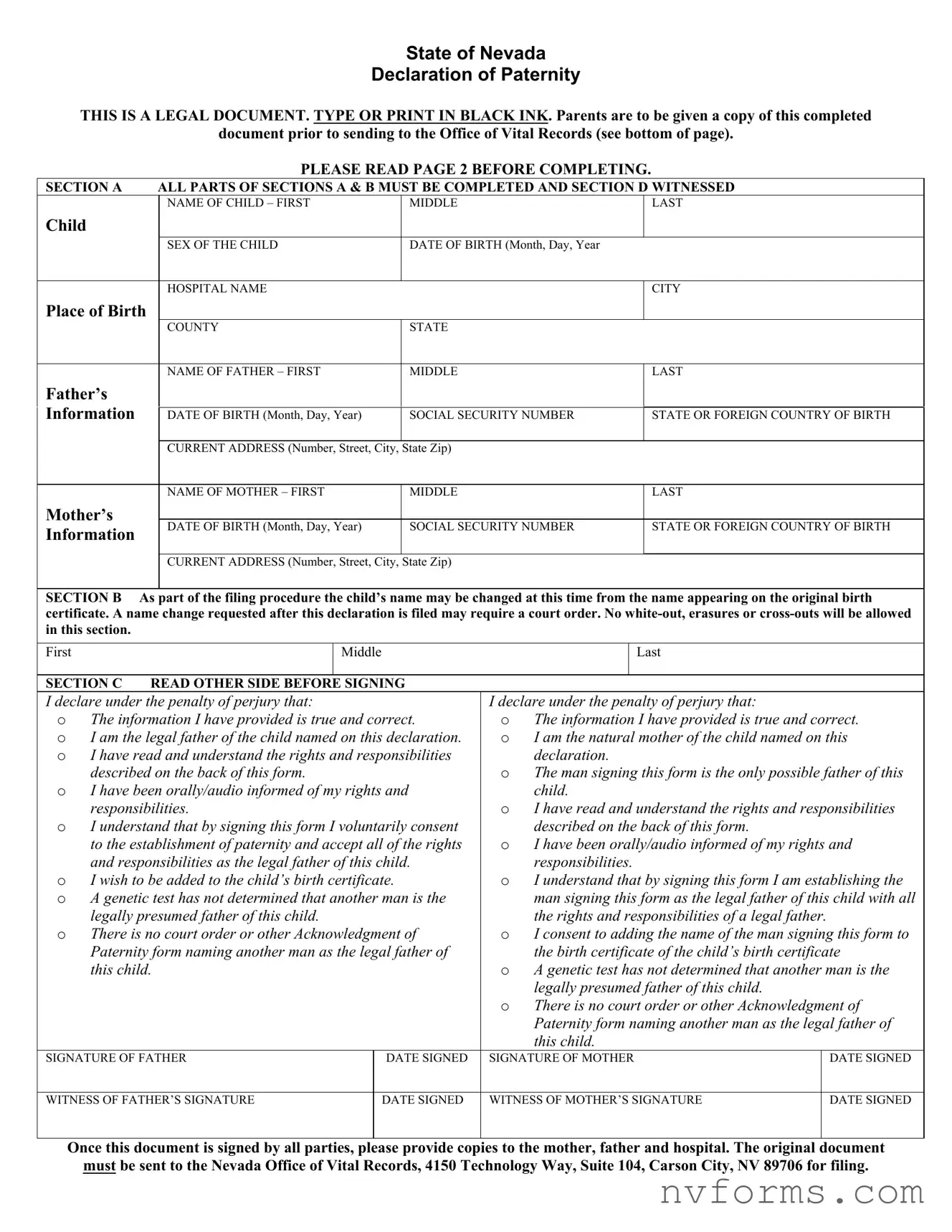
State of Nevada
Declaration of Paternity
THIS IS A LEGAL DOCUMENT. TYPE OR PRINT IN BLACK INK. Parents are to be given a copy of this completed
document prior to sending to the Office of Vital Records (see bottom of page).
PLEASE READ PAGE 2 BEFORE COMPLETING.
SECTION A ALL PARTS OF SECTIONS A & B MUST BE COMPLETED AND SECTION D WITNESSED
NAME OF CHILD – FIRST |
MIDDLE |
LAST |
|
Child |
|
|
|
|
|
|
|
|
|
|
SEX OF THE CHILD |
DATE OF BIRTH (Month, Day, Year |
|
|
|
|
|
|
|
|
HOSPITAL NAME |
|
CITY |
|
Place of Birth |
|
|
|
|
|
COUNTY |
STATE |
|
|
|
|
|
|
|
|
NAME OF FATHER – FIRST |
MIDDLE |
LAST |
|
Father’s |
|
|
|
|
Information |
|
|
|
|
DATE OF BIRTH (Month, Day, Year) |
SOCIAL SECURITY NUMBER |
STATE OR FOREIGN COUNTRY OF BIRTH |
|
|
|
|
|
|
|
CURRENT ADDRESS (Number, Street, City, State Zip) |
|
|
|
|
|
|
|
|
NAME OF MOTHER – FIRST |
MIDDLE |
LAST |
|
Mother’s |
|
|
|
|
DATE OF BIRTH (Month, Day, Year) |
SOCIAL SECURITY NUMBER |
STATE OR FOREIGN COUNTRY OF BIRTH |
|
Information |
|
|
|
|
|
|
|
|
|
|
|
CURRENT ADDRESS (Number, Street, City, State Zip) |
|
SECTION B As part of the filing procedure the child’s name may be changed at this time from the name appearing on the original birth certificate. A name change requested after this declaration is filed may require a court order. No white-out, erasures or cross-outs will be allowed in this section.
SECTION C |
READ OTHER SIDE BEFORE SIGNING |
|
|
|
I declare under the penalty of perjury that: |
|
I declare under the penalty of perjury that: |
|
O |
The information I have provided is true and correct. |
O |
The information I have provided is true and correct. |
O |
I am the legal father of the child named on this declaration. |
O |
I am the natural mother of the child named on this |
O |
I have read and understand the rights and responsibilities |
|
declaration. |
|
|
described on the back of this form. |
|
O |
The man signing this form is the only possible father of this |
O |
I have been orally/audio informed of my rights and |
|
child. |
|
|
responsibilities. |
|
O |
I have read and understand the rights and responsibilities |
O |
I understand that by signing this form I voluntarily consent |
|
described on the back of this form. |
|
|
to the establishment of paternity and accept all of the rights |
O |
I have been orally/audio informed of my rights and |
|
and responsibilities as the legal father of this child. |
|
responsibilities. |
|
O |
I wish to be added to the child’s birth certificate. |
O |
I understand that by signing this form I am establishing the |
O |
A genetic test has not determined that another man is the |
|
man signing this form as the legal father of this child with all |
|
legally presumed father of this child. |
|
|
the rights and responsibilities of a legal father. |
|
O |
There is no court order or other Acknowledgment of |
O |
I consent to adding the name of the man signing this form to |
|
Paternity form naming another man as the legal father of |
|
the birth certificate of the child’s birth certificate |
|
this child. |
|
O |
A genetic test has not determined that another man is the |
|
|
|
|
|
legally presumed father of this child. |
|
|
|
|
|
O |
There is no court order or other Acknowledgment of |
|
|
|
|
|
Paternity form naming another man as the legal father of |
|
|
|
|
|
this child. |
|
SIGNATURE OF FATHER |
DATE SIGNED |
SIGNATURE OF MOTHER |
DATE SIGNED |
WITNESS OF FATHER’S SIGNATURE
DATE SIGNED |
WITNESS OF MOTHER’S SIGNATURE |
Once this document is signed by all parties, please provide copies to the mother, father and hospital. The original document must be sent to the Nevada Office of Vital Records, 4150 Technology Way, Suite 104, Carson City, NV 89706 for filing.
Rights and Responsibilities of Acknowledging Paternity
By Signing This Declaration of Paternity:
1.You are acknowledging that you are the legal father of this child which, after 60 days, creates a legal determination that you are the father.
2.There will be no hearing or trial held on the issue of paternity at this time and you waive your right to genetic testing.
3.You have a duty to financially support the child, which is a separate issue from visitation and custody of the child.
4.A court order may order you to pay child support for the child until the child reaches 18 years of age, or 19 if still in high school, or otherwise declared free from your parental control by a court.
5.A court may order the withholding or assignment of your wages or commissions.
6.A court may order you to furnish health insurance for the child.
7.A court may order you to pay reasonable expenses of the mother’s pregnancy and confinement costs, which include birth expenses and public assistance provided on behalf of the child.
8.You have rights concerning custody and visitation of the child. Please be advised that physical custody of the child is generally granted to the biological unwed mother. If both father and mother cannot agree to an arrangement for visitation and/or custody, then you must pursue a separate legal action through the courts. You may need to hire a private attorney to assist you.
9.Unless you can show special circumstances of fraud, duress or material mistake of fact, under Nevada law you may not be able to petition the court to declare that you are not the legal father of the child. You may need to hire a private attorney to assist you.
10.This declaration of paternity can be revoked or rescinded within 60 days after the filing with the state registrar or within 60 days after you turn 18 years old, whichever is later. However, your name will
remain on the birth certificate until a court declares that you are not the legal father of this child.
__________________________________________________________________________________
Mailing Instructions
Please mail the completed form to the office of Vital Records, 4150 Technology Way, Suite 104, Carson City, Nevada 89706. There is a $40 charge to amend a certificate already on file in the office of Vital Records. This fee includes a certified copy of the amended or new record. Additional copies are $20 each. Please make your cashier’s check or money order out to Nevada Vital Records.
Please allow 4-8 weeks to process your request. Any questions concerning paternity actions should be addressed to the State Office of Vital Records at the above address, or by calling our office at (775)684-4242.
__________________________________________________________
Name
_____________________________________________________________________
Street Address or PO Box
_____________________________________________________________________

